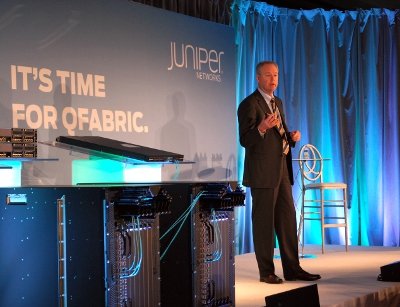Network vendor Juniper on Wednesday unveiled the first product to enable its flat-fabric network architecture for data centers. Called QFabric, the packet-switched networking technology is built to enable construction of data centers over a wide range of scales using standard off-the-shelf computing, storage and services elements.
In addition to reducing network management requirements, Juniper says its new architecture will enable data center operators to benefit from dramatic reductions in floor space, power and cooling requirements.
The product Juniper will be making available during this quarter is the QFX3500 top-of-rack switch. It can act either as a stand-alone switch or as one of the three hardware components of QFabric, which makes it key in enabling transition from a traditional spanning-tree network to the new flat architecture.
Juniper is expecting to start shipping the other two components in the third quarter.
Cisco, Juniper’s biggest rival in the data center space, has also announced a flatter network topology, and so had Brocade. Both Cisco and Brocade announced product roadmaps to enable their flat network architectures last year.
Cisco’s technology is called FabricPath – a new software capability of the vendor’s NX-OS operating system. The hardware piece of FabricPath includes Cisco’s Nexus-7000-series switches fitted out with F-Series line cards. Both the FabricPath software licenses and the F-Series modules are expected to be made available sometime this quarter.
Brocade’s products, launched in November 2010, collapse access and aggregation layers into one. The products are two VDX 6720 switches for Layer 2 10GbE networking.
Kevin Johnson, Juniper CEO, said in a press conference that aim of the three-year R&D project, codenamed "Stratus", which culminated in QFabric, was to eliminate the trade-offs network engineers have had to consider when building data center networks.
"When customers architect data centers today, we would argue that there’s one of three criteria that customers have to optimize around," Johnson said. The criteria are speed, scale or efficiency, and any two of them usually have to be sacrificed to optimize for the third one.
"We’re trying to change that paradigm to enable customers to think in new ways. We believe what’s needed is a fundamental rethink."
With complexities of its implementation hidden, QFabric acts as a single logical packet-switching device. According to Juniper, the architecture has two essential capabilities.
One is it enables data center compute, storage, services and network resources to be treated as "fully fungible pools" that can be partitioned dynamically and quickly. Applications and infrastructure are not aware of details about each other.
The second capability is for resources to be connected to each other at very high speeds with the only limit in the interconnect being interface bandwidth and small transit latency.
Three basic design elements of QFabric are the data plane, the control plane and the management plane.
On the data plane, every port is connected directly to every other port and packets are processed by a single "full look-up". Centralized shared tables on the control plane have information about all ports, managed from a single-point management plane.
The fabric is separated from i/o ports and copper traces are replaced with fiber links, which addresses physical limitations to scalability. Multiple fabric switches are used for redundancy and scale.
The hardware components that enable QFabric are QF Interconnect, QF Node and QF Director.
The director is the brain of the fabric, a 2U x86 box that provides the network with federated intelligence. The Interconnect is a chassis that supports 128 QSPF connectors running at wire speed and providing throughput of up to 10 terabytes per second.
Finally, the Node component is a 1U box that provides 48 SFP+ and SFP ports, supporting both 10GbE and 1GbE. QFX3500, the switch to be rolled out this quarter, acts as a node.
See DatacenterDynamics FOCUS interview with Anjan Venkatrammani, VP of Fabric and Switching Technologies at Juniper, about QFabric and what it will mean for the future of data center networks below:

